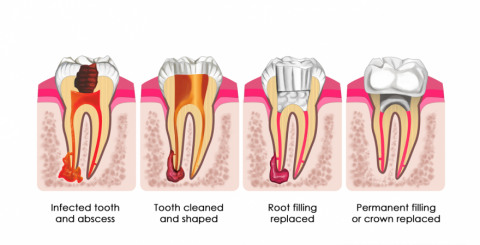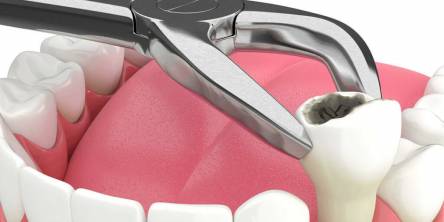Stages of Root Canal Treatment

If you’ve been advised to go for root canal treatment and if this is your first time, you could be nervous. Being informed about what root canal treatment is all about, makes you better prepared and less anxious.
Root canal treatment becomes necessary when the tooth pulp becomes inflamed or infected, leading to severe tooth pain and, eventually, damaging the pulp. Root canal treatment saves the tooth and relieves the pain.
The causes for a root canal could be deep tooth decay, repeated dental procedures on one tooth, trauma such as a crack, chip, or even a root fracture. Sometimes gum disease can also lead to root canal problems necessitating root canal treatment.
Root canal treatment is done in the following steps:
Step 1 – Diagnosis, preparation of the infected site, and rubber dam application - Your dentist will assess the cause for tooth pain after evaluating your medical history and examining the tooth with a radiographic image (X-ray) of the tooth.
Step 2 – Local anesthesia is administered via injections to numb the tooth to be treated and the surrounding tissues. If you are very nervous about the pain, your dentist will use oral sedation to keep you calm during the treatment.
Step 3 – A rubber dam is applied to isolate the infected tooth: This helps the dentist to better access and view the tooth and prevent contamination from the bacteria in the saliva or rest of the mouth.
Step 4 – Accessing the root canal: The root canal is accessed by making a hole in the crown to access the pulp chamber and root canal for treatment. If the back tooth is infected, a hole is made through the biting surface of that affected tooth; if it is the front tooth, the hole is made from behind the tooth to access the pulp chamber.
Step 5 - Cleaning the root canal: The canal is shaped to carry out the disinfection by irrigating the canal. The infected pulp tissue and the damaged nerve are then removed from the root canal. Irrigation of canal disinfects the canal and the pulp chamber with a disinfecting solution.
Step 6 – Shaping the canals: The canals are then shaped with tiny flexible instruments to allow them to receive root canal fillings and sealers.
Step 7 - Sealing the tooth: The cleaned canal is then packed with sealing material called gutta-percha, a biocompatible material. This prevents the entry of microbes and future infections.
Step 8 – Sealing the access hole: A temporary or permanent filling material is placed to seal the access hole (that was made to treat the canals). If the tooth lacks sufficient structure to hold a restoration (filling) in place, a metal post may be placed in one of the canals inside the tooth to help retain it.
Step 9 – Post RCT care: After the procedure, an antibiotic and pain medication may be prescribed to treat or prevent infection and manage pain, if any. Follow the instructions of your dentist or endodontist.
Step 10 – Restoration - Your tooth will need a permanent restoration to replace the lost tooth structure and provide a complete seal to the top of the tooth. The restoration could be a filling or a crown. If you’ve been advised root canal treatment and if this is your first time, you could be apprehensive. Being informed about what root canal treatment is all about, makes you better prepared and less apprehensive.
These are the stages for root canal treatment. If your tooth pulp is infected, then do for root canal treatment. Take the correct medication after the root canal treatment. so that it will cure easily.
Treating root canals require a great deal of precision and care to treat well. Therefore, some of the dentists use state-of-the-art technology including digital (radiographic) imaging to diagnose root canal problems. They use ultrasonic instrumentation to remove old canal fillings and posts and clean canals; and operating microscopes to accurately locate, visualize and seal root canal systems
The whole treatment is quite high-tech and requires highly skilled dentists or endodontists to perform root canal treatment successfully. The dentists who are empathetic and therefore use oral sedation to allay any fear of treatment for the patient.
Similar Articles
The results of wearing Invisalign aligners look stunning, and they are way more convenient than traditional braces. However, no one speaks about what it feels like to wear the same pair of traces around 22 hours a day
Temporomandibular Joint Disorder, commonly known as TMJ, is a condition that causes pain and dysfunction in the jaw joint and surrounding muscles. This disorder can arise from various factors, including teeth grinding, arthritis, jaw injuries, poor posture, or stress.
A root canal is a common treatment that people pay the dentist a visit for. According to a study, root canal treatment claims were up by 42% in the last five years.
Family dentistry isn’t just about teeth—it’s about bringing convenience, care, and a few laughs to your household’s dental game. Think of a family dentist as the Swiss Army knife of oral healthcare, equipped to handle everything from baby teeth to grandma’s bridgework.
Early identification of dental decay is critical. It can aid your dentist in reversing the problem by administering proper therapy. However, the early stages of tooth decay are almost impossible to detect with the human eye.
Cosmetic dentistry is a branch of dental practice that focuses on improving the appearance of teeth, smiles, and overall oral health. This field of dentistry has grown significantly over the past few decades and offers patients a wide variety of procedures to address a wide variety of cosmetic issues.
Ah, the bittersweet moment when a tooth has overstayed its welcome. It’s been with you through thick and thin—chewing your favorite snacks, smiling in photos, and grinding during those stressful nights. But now, it’s time to part ways
Learn 5 signs you may need dentures and discover the steps to get started for a healthier smile and improved quality of life.
Boost patient trust and diagnostic accuracy with high-quality intraoral cameras. Enhance care, improve communication, and streamline operations in your dental practice!









